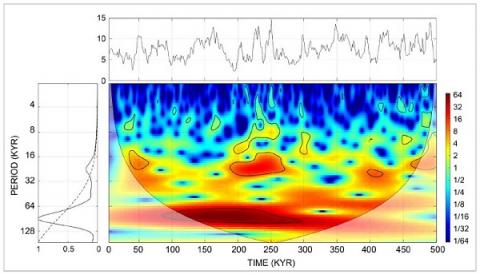Luiggina Cappellotto, María Julia Orgeira, Víctor Manuel Velasco Herrera, Rodolfo Gustavo Cionco
2 022
Global and Planetary Change 213 (2022)
Relationships between geomagnetic field (GF) variations, paleoclimates, and Milankovitch cycles have increasingly attracted the attention of researchers mainly because of the assumption that GF may have acted as a climate forcing, suggesting that GF variations and orbital forcing may be linked in a complex synergistic way, especially, during interglacials and interstadials. We first performed an exhaustive analysis of the relationship between GF, a paleotemperature proxy, astroclimatic parameters, and the summer solstice mean daily insolation at 65 N over the last 500 kyr. We evaluated the relationship between the variables at the orbital scale, using wavelets, cross wavelets, and multiple cross wavelets. Our novel approach to the subject is the use of a new multiple cross wavelet algorithm, which allowed us to simultaneously analyze several data series and determine the relative phases between the signals. We confirm that the eccentricity modulates the GF behavior, and that the precession could have been related to some short-term GF variations. Both orbital parameters seem to be precursors of GF changes. Also, it is especially interesting to investigate the role of the GF reversion events because they could have acted as an indirect climate forcing, and we focused on the relationship among forcings during Marine Isotope Stage (MIS) 5. During this period, two GF reversions (Blake and post-Blake) could have been associated
with relative climate cooling. The consequent lack or weakening of shielding associated with GF events and downward insolation, both influenced by orbital forcing, could finally have promoted a relative global climate cooling during MIS 5.
with relative climate cooling. The consequent lack or weakening of shielding associated with GF events and downward insolation, both influenced by orbital forcing, could finally have promoted a relative global climate cooling during MIS 5.

